Behold the Fukushima!
- Yahoo best answer
- The NWO Jesuits / NWOイエズス会 google検索
- ヨーロッパの新世界秩序はプーチンが暴動を実行させて頂いております
- 日本の福島虐殺か私を納得させる
- イエズス会は世界の人形師
- 福島はイルミナティの人口過疎化プラン
- 福島原発隠蔽
- 人類の未来 阿修羅より
- 第三次世界大戦は "避妊"になるだろうし おそらくそれはすでに始まっている
- パワーエリート脚本、ファシズムや偽国旗=戦争
福島を見よ!
福島の農家は2013年6月6日、日本政府との交渉
Fukushima farmers negotiate with Japanese Government June 6, 2013
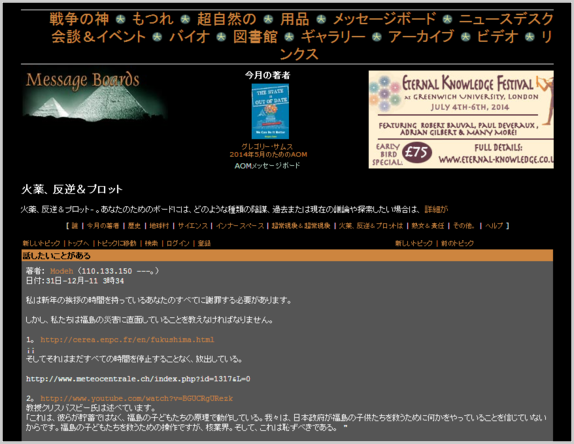
http://www.grahamhancock.com/phorum/read.php?f=6&i=20873&t=20873&v=f
福島:戦争のない核戦争 / Fukushima: A Nuclear War without a War
グローバル·リサーチ·オンライン双方向リーダーシリーズ
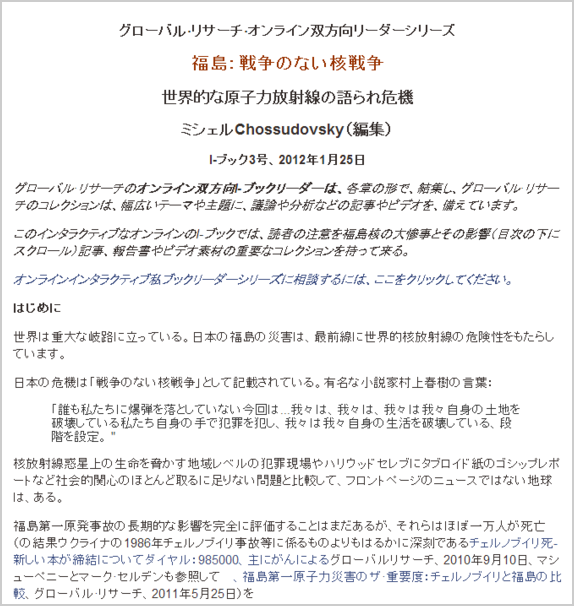
グローバル·リサーチのオンライン双方向I-ブックリーダーは、各章の形で、結集し、グローバル·リサーチのコレクションは、幅広いテーマや主題に、議論や分析などの記事やビデオを、備えています。
Global Research’s Online Interactive I-Book Reader brings together, in the form of chapters, a collection of Global Research feature articles and videos, including debate and analysis, on a broad theme or subject matter.
このインタラクティブなオンラインのI-ブックでは、読者の注意を福島核の大惨事とその影響(目次の下にスクロール)記事、報告書やビデオ素材の重要なコレクションを持って来る。
In this Interactive Online I-Book we bring to the attention of our readers an important collection of articles, reports and video material on the Fukushima nuclear catastrophe and its impacts (scroll down for the Table of Contents).
オンラインインタラクティブ私ブックリーダーシリーズに相談するには、ここをクリックしてください。
To consult our Online Interactive I-Book Reader Series, click here.
http://www.globalresearch.ca/global-research-i-books
はじめに / INTRODUCTION
世界は重大な岐路に立っている。日本の福島の災害は、最前線に世界的核放射線の危険性をもたらしています。
The World is at a critical crossroads.The Fukushima disaster in Japan has brought to the forefront the dangers of Worldwide nuclear radiation.
日本の危機は「戦争のない核戦争」として記載されている。有名な小説家村上春樹の言葉:
The crisis in Japan has been described as “a nuclear war without a war”.In the words of renowned novelist Haruki Murakami:
「誰も私たちに爆弾を落としていない今回は...我々は、我々は、我々は我々自身の土地を破壊している私たち自身の手で犯罪を犯し、我々は我々自身の生活を破壊している、段階を設定。 」
“This time no one dropped a bomb on us … We set the stage, we committed the crime with our own hands, we are destroying our own lands, and we are destroying our own lives.”
核放射線惑星上の生命を脅かす地域レベルの犯罪現場やハリウッドセレブにタブロイド紙のゴシップレポートなど社会的関心のほとんど取るに足りない問題と比較して、フロントページのニュースではない地球は、ある。
Nuclear radiation –which threatens life on planet earth– is not front page news in comparison to the most insignificant issues of public concern, including the local level crime scene or the tabloid gossip reports on Hollywood celebrities.
福島第一原発事故の長期的な影響を完全に評価することはまだあるが、それらはほぼ一万人が死亡(の結果ウクライナの1986年チェルノブイリ事故等に係るものよりもはるかに深刻であるチェルノブイリ死-新しい本が締結についてダイヤル:985000、主にがんによるグローバルリサーチ、2010年9月10日、マシューペニーとマーク·セルデンも参照して 、福島第一原子力災害のザ·重要度:チェルノブイリと福島の比較、グローバル·リサーチ、2011年5月25日)を
While the long-term repercussions of the Fukushima Daiichi nuclear disaster are yet to be fully assessed, they are far more serious than those pertaining to the 1986 Chernobyl disaster in the Ukraine, which resulted in almost one million deaths (New Book Concludes – Chernobyl death toll: 985,000, mostly from cancer Global Research, September 10, 2010, See also Matthew Penney and Mark Selden The Severity of the Fukushima Daiichi Nuclear Disaster: Comparing Chernobyl and Fukushima, Global Research, May 25, 2011)
-
福島第一原子力災害の危険度:チェルノブイリと福島の比較
The Severity of the Fukushima Daiichi Nuclear Disaster: Comparing Chernobyl and Fukushima
また、すべての目は、日本で、国際的に完全に東京電力(東京電力株式会社)福島第二原子力発電所の第二の大災害の影響を認めることができなかった、両方の福島第一原発、ニュース報道に釘付けにしている間。
Moreover, while all eyes were riveted on the Fukushima Daiichi plant, news coverage both in Japan and internationally failed to fully acknowledge the impacts of a second catastrophe at TEPCO’s (Tokyo Electric Power Co Inc) Fukushima Daini nuclear power plant.
日本、米国と西ヨーロッパの両方の不安定な政治的コンセンサスが福島での危機が含まれていることである。
The shaky political consensus both in Japan, the U.S. and Western Europe is that the crisis at Fukushima has been contained.
realtiesは、しかし、そうでない場合があります。福島3は、プルトニウムの未確認量をリークしていました。博士ヘレンコルディコットによると、「プルトニウムのグラムの百万分の一は、吸入すると、がんを引き起こす可能性があります」。
The realties, however, are otherwise.Fukushima 3 was leaking unconfirmed amounts of plutonium.According to Dr. Helen Caldicott, “one millionth of a gram of plutonium, if inhaled can cause cancer”.
2011年5月の世論調査は、日本の人口の80パーセントは、核危機に関する政府の情報を信じていないことを確認した。(シャーウッドロス、で引用:日本の2回目の核災害福島、グローバル·リサーチ、2011年11月10日)
An opinion poll in May 2011 confirmed that more than 80 per cent of the Japanese population do not believe the government's information regarding the nuclear crisis.(quoted in Sherwood Ross, Fukushima: Japan's Second Nuclear Disaster , Global Research, November 10, 2011)
-
福島:日本の2回目の核災害 / Fukushima: Japan’s Second Nuclear Disaster
日本での影響 / The Impacts in Japan
日本政府は「核危機の深刻度は... 1986年チェルノブイリ事故のそれと一致した」ことを認めることが義務付けされています。苦い皮肉では、しかし、日本当局によるこの暗黙の承認は、グローバルな核放射線汚染の過程で、その結果、かなり大きな大惨事の隠蔽のあった部分が証明されている。
The Japanese government has been obliged to acknowledge that “the severity rating of its nuclear crisis … matches that of the 1986 Chernobyl disaster”. In a bitter irony, however, this tacit admission by the Japanese authorities has proven to been part of the cover-up of a significantly larger catastrophe, resulting in a process of global nuclear radiation and contamination:
チェルノブイリは膨大未曾有の災害であったが、「それだけで1原子炉で発生したと急速に融解した。
“While Chernobyl was an enormous unprecedented disaster, it only occurred at one reactor and rapidly melted down.
一度冷却し、その10万の労働者で構成された具体的な石棺で覆われていることができました。
Once cooled, it was able to be covered with a concrete sarcophagus that was constructed with 100,000 workers.
大幅にチェルノブイリの放射線源の合計サイズを矮星福島で核燃料棒の驚異的な4400トンがあります」(日本では非常に高い放射線レベルは:大学の研究者の挑戦オフィシャルデータ、グローバル·リサーチ、2011年4月11日)は、
There are a staggering 4400 tons of nuclear fuel rods at Fukushima, which greatly dwarfs the total size of radiation sources at Chernobyl.” ( Extremely High Radiation Levels in Japan: University Researchers Challenge Official Data , Global Research, April 11, 2011)
-
日本では非常に高い放射線レベル:大学の研究者の挑戦オフィシャルデータ
Extremely High Radiation Levels in Japan: University Researchers Challenge Official Data
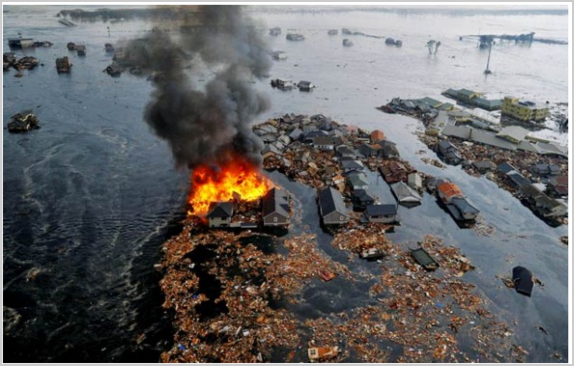
津波、2011年3月をきっかけに福島 / Fukushima in the wake of the Tsunami, March 2011
世界的な汚染 / Worldwide Contamination
太平洋に放射性の高い水の投棄は、グローバルな放射能汚染の処理に潜在的なトリガーとなっている。放射性元素は、日本の食物連鎖で検出されているだけではなく、放射性雨水は、カリフォルニア州で記録されている:
The dumping of highly radioactive water into the Pacific Ocean constitutes a potential trigger to a process of global radioactive contamination. Radioactive elements have not only been detected in the food chain in Japan, radioactive rain water has been recorded in California:
それから、あるいは土壌、草、牛の肉や牛乳、「福島の周りの海や空気中に放出されて有害放射性元素は、藻類、甲殻類、小魚、大きな魚、そしてヒトに、例えば(様々な食物連鎖の各段階で蓄積ヒト)。
“Hazardous radioactive elements being released in the sea and air around Fukushima accumulate at each step of various food chains (for example, into algae, crustaceans, small fish, bigger fish, then humans; or soil, grass, cow's meat and milk, then humans).
身体に入ると、これらの元素-内部エミッターと呼ばれる-例えば、甲状腺、肝臓、骨、および脳、連続的にアルファ、ベータおよび/ またはガンマ放射線の高用量の細胞の小容積を照射し、長年にわたるような特定の器官への移行多くの場合、「癌を誘発する。
Entering the body, these elements – called internal emitters – migrate to specific organs such as the thyroid, liver, bone, and brain, continuously irradiating small volumes of cells with high doses of alpha, beta and/or gamma radiation, and over many years often induce cancer”.
(ヘレンコルディコット、福島原子力擁護は、放射線にメッセンジャーを撃つ再生、年齢、2011年4月26日)
(Helen Caldicott, Fukushima: Nuclear Apologists Play Shoot the Messenger on Radiation , The Age, April 26, 2011)
-
福島原子力擁護は、放射線にメッセンジャーを撃つ再生
Fukushima: Nuclear Apologists Play Shoot the Messenger on Radiation
北米の西海岸への放射線の広がりがさりげなく認めたが、「外交筋を引用し「早期報道(APとロイターは)放射性粒子の唯一の "小さな金額はカリフォルニアに到着したが、これらに脅威を与えていないと述べている人間の健康。 "
While the spread of radiation to the West Coast of North America was casually acknowledged, the early press reports (AP and Reuters) “quoting diplomatic sources” stated that only “tiny amounts of radioactive particles have arrived in California but do not pose a threat to human health.”
「報道機関によると、無名のソースは、国連の包括的核実験禁止条約機構が運営する所を測定したネットワークからデータにアクセスすることができます。···
“According to the news agencies, the unnamed sources have access to data from a network of measuring stations run by the United Nations’ Comprehensive Test Ban Treaty Organization. …
···グレッグJaczko、米国原子力規制委員会の議長は、彼の専門家は「米国や米国の領土のいずれかで、ここで有害である可能性の放射線レベルから任意の懸念が表示されないことを木曜日(3月17日)にホワイトハウスの記者団に語った」。
… Greg Jaczko, chair of the U.S. Nuclear Regulatory Commission, told White House reporters on Thursday (March 17) that his experts “don’t see any concern from radiation levels that could be harmful here in the United States or any of the U.S. territories”.
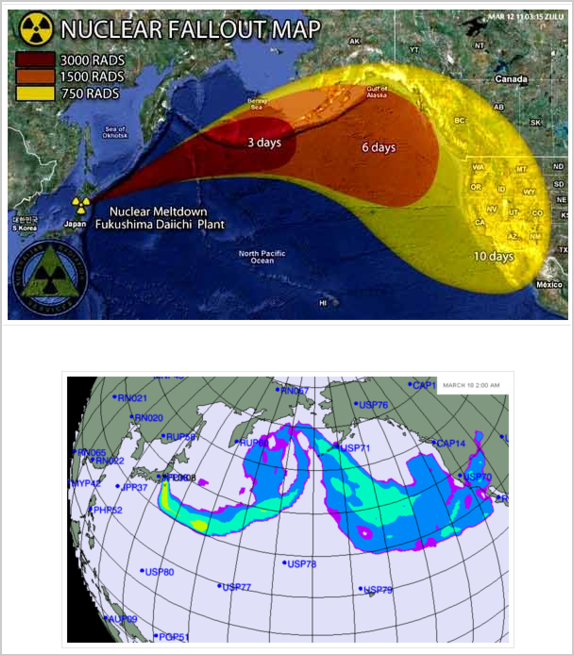
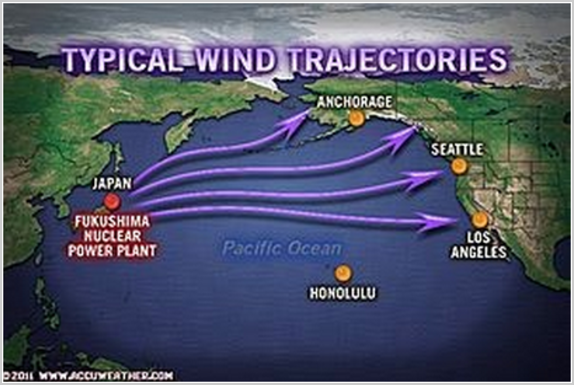
放射線の広がり。2011年3月 / The spread of radiation. March 2011
公衆衛生の災害。経済的影響
Public Health Disaster. Economic Impacts
何が勝つことはよく組織カモフラージュです。日本における公衆衛生の災害、水、農地及び食物連鎖の汚染、はもちろん、より広い経済的·社会的影響は、どちらも完全に認めてもなく日本の当局による包括的かつ有意義な方法で対処されている。
What prevails is a well organized camouflage. The public health disaster in Japan, the contamination of water, agricultural land and the food chain, not to mention the broader economic and social implications, have neither been fully acknowledged nor addressed in a comprehensive and meaningful fashion by the Japanese authorities.
国民国家としての日本が破壊されています。その国土と領海は汚染されている。国の一部は住めないです。高レベルの放射線が(34万円(2010)年頃、カナダの人口よりも多く)3900万(2010)の人口は、首都圏に記録された食物連鎖が日本全国に汚染されていることを指摘があります。
Japan as a nation state has been destroyed. Its landmass and territorial waters are contaminated. Part of the country is uninhabitable. High levels of radiation have been recorded in the Tokyo metropolitan area, which has a population of 39 million (2010) (more than the population of Canada, circa 34 million (2010)) There are indications that the food chain is contaminated throughout Japan:
法的制限を超える放射性セシウムを超える300キロ離れて福島第一原子力発電所から、静岡市の工場で作ったお茶で検出された。静岡県は日本で最も有名な茶産地の一つです。
Radioactive cesium exceeding the legal limit was detected in tea made in a factory in Shizuoka City, more than 300 kilometers away from the Fukushima Daiichi nuclear power plant. Shizuoka Prefecture is one of the most famous tea producing areas in Japan.
東京のお茶の販売代理店は、市内から出荷お茶に高レベルの放射能を検出したことを県に報告した。県は、製品を出荷を控えるように工場を命じた。福島原子力発電所の事故後、茶葉や製茶の放射能汚染は、東京の周りの広い範囲で発見された。(参照5より多くの企業が福島から300キロ以上法的限度を超える彼らの茶で放射線を検出する、2011年6月15日)
A tea distributor in Tokyo reported to the prefecture that it detected high levels of radioactivity in the tea shipped from the city. The prefecture ordered the factory to refrain from shipping out the product. After the accident at the Fukushima nuclear power plant, radioactive contamination of tea leaves and processed tea has been found over a wide area around Tokyo. (See 5 More Companies Detect Radiation In Their Tea Above Legal Limits Over 300 KM From Fukushima, June 15, 2011)
日本の産業と製造拠点はサジダです。日本はもはや主要な産業用電源ではありません。同国の輸出が急落している。東京政府は1980年以来初の貿易赤字を発表した。
Japan’s industrial and manufacturing base is prostrate. Japan is no longer a leading industrial power. The country’s exports have plummeted. The Tokyo government has announced its first trade deficit since 1980.
ビジネスメディアが狭く生産活動のペースに停電やエネルギー不足の影響を中心にしたが、国のインフラや産業基盤のあからさまな放射能汚染に関連する広範な問題は、放射すなわち、「科学的なタブー」(ある産業プラント、機械設備、建物、道路など)。
While the business media has narrowly centered on the impacts of power outages and energy shortages on the pace of productive activity, the broader issue pertaining to the outright radioactive contamination of the country's infrastructure and industrial base is a “scientific taboo” (ie the radiation of industrial plants, machinery and equipment, buildings, roads, etc).
全国の道路や住宅をcludingで、建設業界で使用される建築材料の核汚染に月に2012ポイントを発表した報告書(参照してください。 福島:放射性住宅と日本の道路を200以上の建設会社に販売放射性建材、 2012年1月)
A report released in January 2012 points to the nuclear contamination of building materials used in the construction industry, in cluding roads and residential buildings throughout Japan.(See FUKUSHIMA: Radioactive Houses and Roads in Japan. Radioactive Building Materials Sold to over 200 Construction Companies, January 2012)
-
福島:放射性住宅と日本の道路。200以上の建設会社に売却された放射性の建築材料
FUKUSHIMA: Radioactive Houses and Roads in Japan.Radioactive Building Materials Sold to over 200 Construction Companies
と題し、経済産業省(2011年5月)による「隠蔽工作報告」、「経済東日本大震災の影響と回復の現状は、「 Aとして「経済回復」を提示既成事実。それはまた別としてブラシ放射線の問題。労働力、国の産業基盤に核放射線の影響については言及されていない。
A “coverup report” by the Ministry of Economy, Trade and Industry (May 2011), entitled “ Economic Impact of the Great East Japan Earthquake and Current Status of Recovery “ presents “Economic Recovery” as a fait accompli. It also brushes aside the issue of radiation.The impacts of nuclear radiation on the work force and the country's industrial base are not mentioned.
報告書は、経済産業省(東京·福島第一との間の距離は230キロ(約144マイル)のオーダーであり、東京の放射線のレベルは、香港とニューヨークに比べて低いことと述べて、展覧会産業、東日本大震災の影響と回復の現状、 P.15 )。
The report states that the distance between Tokyo -Fukushima Dai-ichi is of the order of 230 km (about 144 miles) and that the levels of radiation in Tokyo are lower than in Hong Kong and New York City.(Ministry of Economy, Trade and Industry, Impact of the Great East Japan Earthquake and Current Status of Recovery , p.15 ) .
http://www.meti.go.jp/english/earthquake/recovery/pdf/20110516_impact.pdf
このステートメントは、証拠を裏付けることなく、東京の独立した放射線の測定値(SE下記マップ)明白な矛盾で作られています。最近の動向では、綜合警備保障(株)は、収益性の高い「東京の世帯と4周囲の県を対象とした放射線測定サービス」を立ち上げる。
This statement is made without corroborating evidence and in overt contradiction with independent radiation readings in Tokyo (se map below). In recent developments, Sohgo Security Services Co. is launching a lucrative “radiation measurement service targeting households in Tokyo and four surrounding prefectures”.
「市民測定された放射線レベルのマップは放射能を示し 山岳地帯、地図の下の中央にある東京の北、日本の広範な領域にわたってシフト風を反映した複雑なパターンに分布している。 」
“A map of citizens’ measured radiation levels shows radioactivity is distributed in a complex pattern reflecting the mountainous terrain and the shifting winds across a broad area of Japan north of Tokyo which is in the center of the of bottom of the map.”
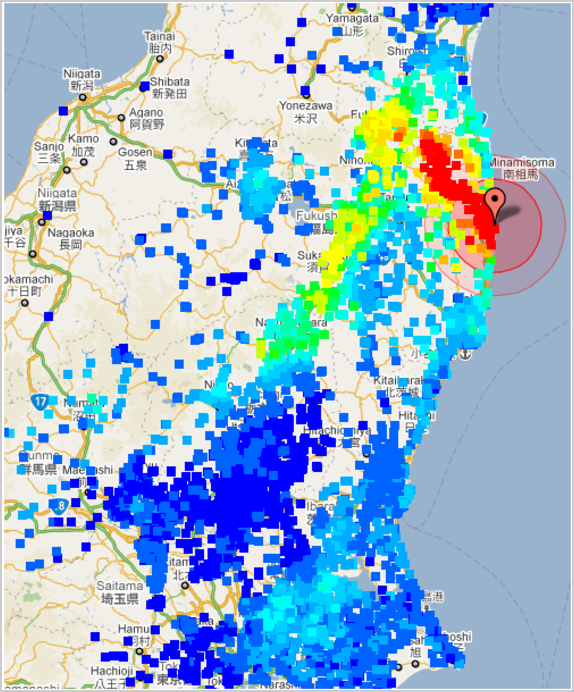
-
ソース:科学マガジン / SOURCE: Science Magazine
日本が危険なほどの放射能で汚染されている / Japan is dangerously contaminated by radioactivity
「放射線の制限だけで0.1マイクロシー/時間の青の上で超過され始める。赤は5.0マイクロシー/時で約50倍の民間放射限界である。子供たちははるかに敏感大人よりなので、これらの結果は、潜在的に影響を受けた地域の幼児の親のための大きな懸念である。 」
“Radiation limits begin to be exceeded at just above 0.1 microsieverts/ hour blue. Red is about fifty times the civilian radiation limit at 5.0 microsieverts/hour. Because children are much more sensitive than adults, these results are a great concern for parents of young children in potentially affected areas.”
ハイテク部品、機械、エレクトロニクス、自動車などを含めて - - とエクスポートワールドワイド·汚染されている基本的な質問は、「日本製」工業製品とコンポーネントの広大な配列はどうでしょうか?
The fundamental question is whether the vast array of industrial goods and components “Made in Japan” — including hi tech components, machinery, electronics, motor vehicles, etc — and exported Worldwide are contaminated?
これが事実であるとされ、全体の東·東南アジアの産業基盤 - 日本の部品·産業技術-だろ影響を受ける可能性に大きく依存します。国際貿易への潜在的影響は遠大だろう。
Were this to be the case, the entire East and Southeast Asian industrial base –which depends heavily on Japanese components and industrial technology– would be affected. The potential impacts on international trade would be farreaching.
この点で、1月に、ロシア当局はロシア連邦での販売のためウラジオストクの港で照射日本の自動車や自動車部品を押収した。言うまでもなく、グローバルな競争環境ではこの種の事件は、危機に既にある日本の自動車産業の崩壊につながる可能性があります。
In this regard, in January, Russian officials confiscated irradiated Japanese automobiles and autoparts in the port of Vladivostok for sale in the Russian Federation. Needless to say, incidents of this nature in a global competitive environment, could lead to the demise of the Japanese automobile industry which is already in crisis.
自動車産業のほとんどが中部日本にある間、いわき市の日産のエンジン工場は、福島第一原発から42キロです。日産労働力が影響を受けますか?エンジン工場は、汚染されていませんか?プラント(下記マップ参照)に約20万人が避難した元政府の「避難区域」の約10〜20㎞以内です。
While most of the automotive industry is in central Japan, Nissan’s engine factory in Iwaki city is 42 km from the Fukushima Daiichi plant. Is the Nissan work force affected? Is the engine plant contaminated? The plant is within about 10 to 20 km of the government’s “evacuation zone” from which some 200,000 people were evacuated (see map below).
原子力と核戦争 / Nuclear Energy and Nuclear War
日本の危機はまた、原子力エネルギーと核戦争の間にオープンな暗黙の関係にもたらした。
The crisis in Japan has also brought into the open the unspoken relationship between nuclear energy and nuclear war.
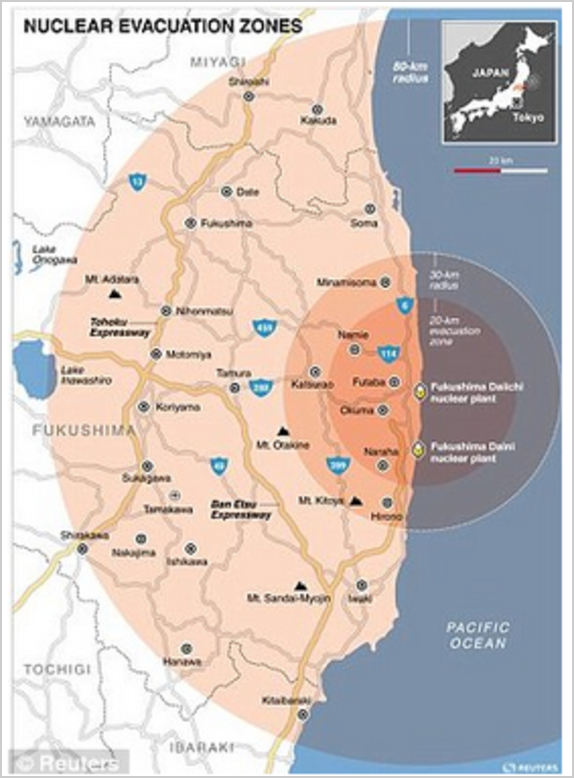
原子力エネルギーは、民間の経済活動ではありません。それは、いわゆる防衛請負業者によって制御され、核兵器産業の付属物である。核エネルギーと核兵器の背後にある強力な企業の利益が重なっている。
Nuclear energy is not a civilian economic activity. It is an appendage of the nuclear weapons industry which is controlled by the so-called defense contractors. The powerful corporate interests behind nuclear energy and nuclear weapons overlap.
災害時の高さで、日本では「原子力産業や政府機関は、日本の民生用原子力発電所の中に隠さ原爆研究施設の発見を防ぐために、スクランブリング[た]「0.1(洋一しまっ、参照秘密兵器プログラム内部福島原子力発電所?グローバルリサーチ、2011年4月12日)
In Japan at the height of the disaster, “the nuclear industry and government agencies [were] scrambling to prevent the discovery of atomic-bomb research facilities hidden inside Japan’s civilian nuclear power plants”.1 (See Yoichi Shimatsu, Secret Weapons Program Inside Fukushima Nuclear Plant? Global Research, April 12, 2011)
-
秘密兵器プログラム内部で福島原子力発電所?
Secret Weapons Program Inside Fukushima Nuclear Plant? - 不可解な4号炉 / Inexplicable No. 4 reactor
それは、核放射線の危険性へのメディアと政府の両方の自己満足は核兵器の使用にするだけでなく、原子力産業に関係することに留意すべきである。どちらの場合も、核放射線の壊滅的な健康への影響は、さりげなく拒否されます。最大で6倍の広島原爆の爆発的な能力を持つ戦術核兵器」は、周囲の民間人のために安全」と国防総省によってラベル付けされる。
It should be noted that the complacency of both the media and the governments to the hazards of nuclear radiation pertains to the nuclear energy industry as well as to to use of nuclear weapons. In both cases, the devastating health impacts of nuclear radiation are casually denied. Tactical nuclear weapons with an explosive capacity of up to six times a Hiroshima bomb are labelled by the Pentagon as “safe for the surrounding civilian population”.
心配は、非核保有国に対して「一般市民のための安全な」戦術核兵器を使用して、イランへの米国のNATO·イスラエル攻撃の可能性が高い結果に政治レベルで発現されていない。
No concern has been expressed at the political level as to the likely consequences of a US-NATO-Israel attack on Iran, using “safe for civilians” tactical nuclear weapons against a non-nuclear state.
このようなアクションは、「考えられない」につながる:中近東および中央アジアの大部分の上の核ホロコースト。核の悪夢は、しかし、核兵器が使用されなかった場合でも発生します。通常兵器を使用してイランの核施設への爆撃は、大規模な放射性降下物と別の福島型災害を解き放つに貢献する。
Such an action would result in “the unthinkable”: a nuclear holocaust over a large part of the Middle East and Central Asia. A nuclear nightmare, however, would occur even if nuclear weapons were not used. The bombing of Iran’s nuclear facilities using conventional weapons would contribute to unleashing another Fukushima type disaster with extensive radioactive fallout.
(詳細は、ミシェルChossudovskyを参照してください、第三次世界大戦のシナリオに向けて核戦争の危険性、グローバルリサーチ、モントリオール、2011年)
(For further details See Michel Chossudovsky, Towards a World War III Scenario, The Dangers of Nuclear War, Global Research, Montreal, 2011)
-
第三次世界大戦のシナリオに向けて
Towards a World War III Scenario
福島でのオンライン双方向のIブックリーダー:戦争のない核戦争
The Online Interactive I-Book Reader on Fukushima: A Nuclear War without a War
公式の隠蔽やメディア偽情報のキャンペーンを考慮すると、このオンラインインタラクティブReaderで記事やビデオ·レポートの内容は、広範な大衆にまで伝わっていない。(下記の目次をご参照ください)
In view of the official cover-up and media disinformation campaign, the contents of the articles and video reports in this Online Interactive Reader have not trickled down to to the broader public. (See Table of contents below)
福島でこのオンラインインタラクティブReaderは、分析や科学論文、ビデオレポートだけでなく、短いニュース報道と裏付けデータの組み合わせが含まれています。
This Online Interactive Reader on Fukushima contains a combination of analytical and scientific articles, video reports as well as shorter news reports and corroborating data.
第I部では、に焦点を当て、福島原子力災害:?それは起こったのかパートIIは、 に関係する。日本では壊滅的な保健社会への影響に関する第III部のセンター"隠れ核の大惨事」、日本政府と企業のメディアによる、すなわち隠蔽。第IV部の問題に焦点を当て 皆様方原子力放射線見直し、パートV 国際原子力エネルギー·産業福島の災害の意味する。
Part I focusses on The Fukushima Nuclear Disaster: How it Happened? Part II pertains to The Devastating Health and Social Impacts in Japan. Part III centers on the “Hidden Nuclear Catastrophe”, namely the cover-up by the Japanese government and the corporate media. Part IV focusses on the issue of Worlwide Nuclear Radiation and Part V reviews the Implications of the Fukushima disaster for the Global Nuclear Energy Industry.
また、政府の共謀、メディア、原子力産業を指しながら、絶え間ないメディア偽情報に直面して、このグローバル·リサーチ·オンラインI-ブックは、グローバルな核放射線の危険性について、メディアの真空を解除し、国民の意識を高めることを意図している。
In the face of ceaseless media disinformation, this Global Research Online I-Book on the dangers of global nuclear radiation is intended to break the media vacuum and raise public awareness, while also pointing to the complicity of the governments, the media and the nuclear industry.
私たちは言葉を広めるために私たちの読者呼びかける。
We call upon our readers to spread the word.
我々は彼らの学生に福島でこのインタラクティブなリーダーを使用できるように、大学、大学や高校の教師を招待します。
We invite university, college and high school teachers to make this Interactive Reader on Fukushima available to their students.
ミシェルChossudovsky、2012年1月25日
Michel Chossudovsky, January 25, 2012
続きはグーロバルリサーチで
It has its global GlobalResearch
グローバルリサーチ ホーム / Global Research Home
貧困と新世界秩序のグローバル化ミシェルChossudovsky
Globalization of Poverty and the New World Order by Michel Chossudovsky
隠す場所がないー福島の放射性降下物
No Place to Hideーfukushima fallout Findings Widespread
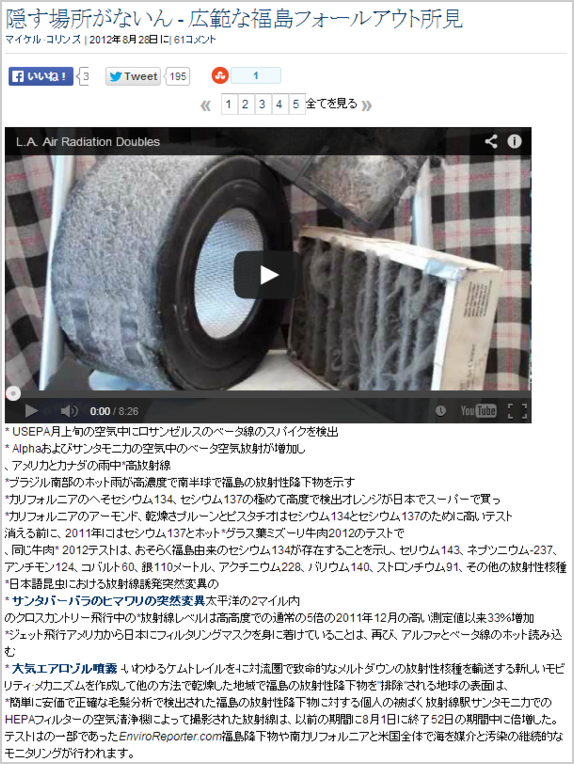
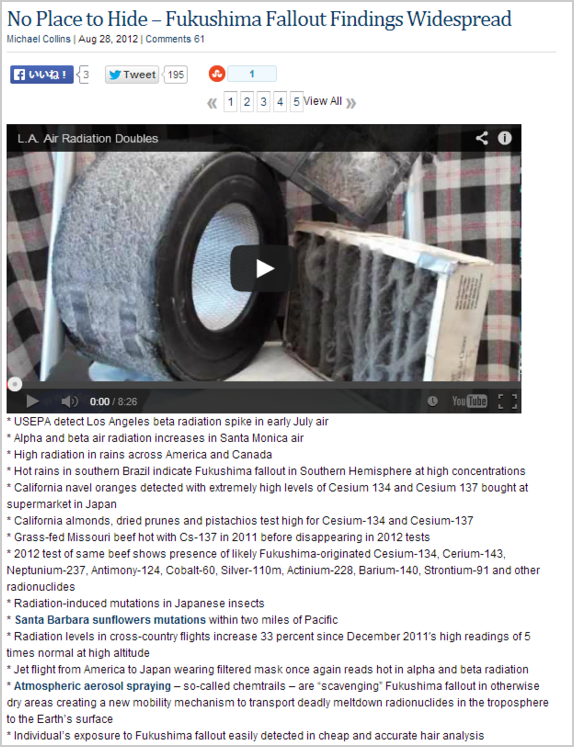
http://www.enviroreporter.com/2012/08/no-place-to-hide-fukushima-fallout-findings-widespread/all/1/
上昇した放射線は、東京で2020年のオリンピック開催地を主張
Elevated radiation claimed at Tokyo 2020 Olympic venues
市民グループは、キー東京ゲーム施設の現場でのテストを行いますが、調査結果と主催者は慎重専門家は問題を見ない
Citizens' group carries out tests at sites for key Tokyo Games facilities, but expert cautious about findings and organisers see no problem
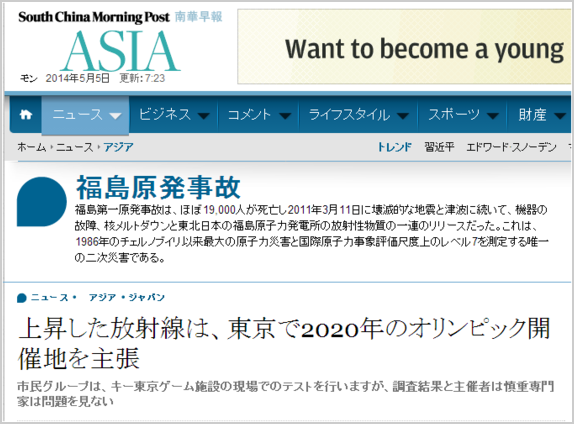
http://www.scmp.com/news/asia/article/1329729/elevated-radiation-claimed-tokyo-2020-olympic-venues
東京の放射線オリンピック
Tokyo's Radiation Olynpics

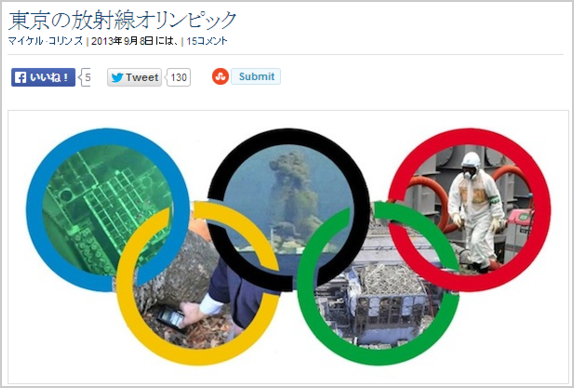
http://www.enviroreporter.com/2013/09/tokyos-radiation-olympics/
福島放射線で我々の子供たちは死んで、政府は真実を隠しますー 前市長(双葉町前町長)
Fukushima radiation killing our children, govt hides truth - former mayor
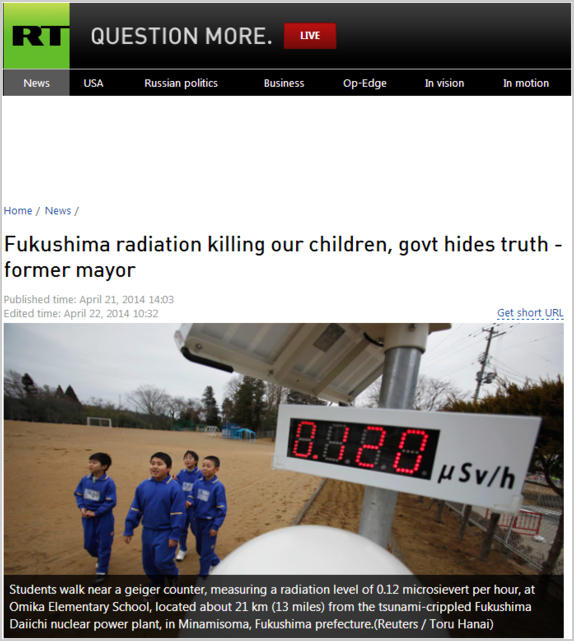
学生は南相馬市、福島県の津波不自由福島第一原子力発電所から約21キロ(13マイル)に位置、Omika小学校で、毎時0.12マイクロシーベルトの放射線レベルを測定、ガイガーカウンターの近くに歩いてください。(ロイター/徹花井)
Students walk near a geiger counter, measuring a radiation level of 0.12 microsievert per hour, at Omika Elementary School, located about 21 km (13 miles) from the tsunami-crippled Fukushima Daiichi nuclear power plant, in Minamisoma, Fukushima prefecture.(Reuters / Toru Hanai)
その子 - Katsutaka Idogawa 井戸川克隆 、双葉、無効福島原子力発電所の近くに町の市長は、放射能汚染は、日本の最大の宝物に影響を及ぼしていることを自分の国に警告している。
Katsutaka Idogawa, former mayor of Futaba, a town near the disabled Fukushima nuclear plant, is warning his country that radiation contamination is affecting Japan’s greatest treasure – its children.
いわき市に双葉町の人々を再配置する政府の計画について尋ねた、福島県内、 Idogawa 井戸川克隆 としての動きを批判し、「人権侵害」。
Asked about government plans to relocate the people of Fatuba to the city of Iwaki, inside the Fukushima prefecture, Idogawa criticized the move as a “violation of human rights.”
チェルノブイリと比較して、福島の周りの放射線レベルが「 4倍である」と彼は付け加え、 RTのソフィーシェワルナゼに語った「人々が戻って福島県に来てのはまだ早い。 "
Compared with Chernobyl, radiation levels around Fukushima “are four times higher,” he told RT’s Sophie Shevardnadze, adding that “it’s too early for people to come back to Fukushima prefecture.”
「それは関係なく、政府が言うことを、決して安全ではありません。 」
“It is by no means safe, no matter what the government says.”
Idogawa 井戸川克隆 は、政府が、放射線の危険性にもかかわらず、彼らの町に人を戻すためのプログラムを開始したことを主張している。
Idogawa alleges that the government has started programs to return people to their towns despite the danger of radiation.
「福島県は来るホームのキャンペーンを開始した。多くの場合、避難者を返すように強制される。 [前市長は、空気汚染がやや減少していることを示したが、土壌汚染が同じで福島県の地図を制作。 」 "
“Fukushima Prefecture has launched the Come Home campaign. In many cases, evacuees are forced to return. [the former mayor produced a map of Fukushima Prefecture that showed that air contamination decreased a little, but soil contamination remains the same.]"
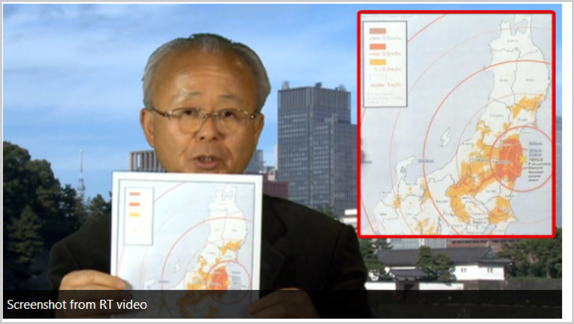
Idogawaによるとそこに報告している県内に居住する約200万人、「医療問題のすべての種類は、 「あるが、政府はこれらの条件は、福島の事故とは無関係であると主張する。 Idogawaは、書面でその否定を望んでいる。
According to Idogawa there are about two million people residing in the prefecture who are reporting “all sorts of medical issues,” but the government insists these conditions are unrelated to the Fukushima accident. Idogawa wants their denial in writing.
「私は、当局が書面でその主張を立証することを要求したが、彼らは私の要求を無視していました。 」
“I demanded that the authorities substantiate their claim in writing but they ignored my request.”
もう一度、 Idogawa日本人がいることを訴え、 1986年4月26日にウクライナを襲った核の悲劇を暗示「チェルノブイリを決して忘れない。 「しかし、少数の人々は、元公務員の警告を聞き入れているようだ。
Once again, Idogawa alludes to the nuclear tragedy that hit Ukraine on April 26, 1986, pleading that the Japanese people “never forget Chernobyl.” Yet few people seem to be heeding the former government official’s warning.
実際に放射線がまだそこにいる間に「彼らは、政府の言うことを信じています。これは子供を殺している。彼らは心臓病で死亡、喘息、白血病、甲状腺炎···子供たちの多くは、非常に学校の後に排出されます。他の人は単純に、PEの授業に出席することはできません。しかし、当局は、まだ私たちから真実を隠して、私はなぜ知らない。彼らは自分の子を持っていないのですか?それは彼らが私達の子供を保護することはできません知っているそんなに痛い。
“They believe what the government says, while in reality radiation is still there. This is killing children. They die of heart conditions, asthma, leukemia, thyroiditis… Lots of kids are extremely exhausted after school; others are simply unable to attend PE classes. But the authorities still hide the truth from us, and I don’t know why. Don’t they have children of their own? It hurts so much to know they can’t protect our children.
「彼らは、福島県が安全であると言う、そして誰もが子供たちを避難させる作業していない理由です、他の場所に移動します。我々としても、これを議論するために許可されていない。 」
“They say Fukushima Prefecture is safe, and that’s why nobody’s working to evacuate children, move them elsewhere. We’re not even allowed to discuss this.”
前市長は、皮肉な2020に予定の東京オリンピックを議論する際に、安倍首相が頻繁に文字通りあなたがすべきことを意味する日本語の単語、 「おもてなし」に言及していることを発見、 "オープンハートを持つ人々を治療する。 "
The former mayor found it ironic that when discussing the Tokyo Olympics, scheduled for 2020, Prime Minister Abe frequently mentions the Japanese word, “omotenashi,” which literally means that you should “treat people with an open heart.”
クリーンアップ操作に関わる労働者: Idogawaの意見では、同じ処理が最も密接に福島に接続しているユーザーにも等しく適用されません。
In Idogawa’s opinion, the same treatment does not apply equally to the people most intimately connected with Fukushima: the workers involved in the cleanup operations.
「自社の機器が悪くなっていた。準備が悪化した。だから、人々が最初に彼らの安全を考えなければならなかった。放射線の真の危険性を理解した人が辞めになった理由です。今、私たちは、専門外の人々が働いている。
“Their equipment was getting worse; preparation was getting worse. So people had to think about their safety first. That’s why those who understood the real danger of radiation began to quit. Now we have unprofessional people working there.
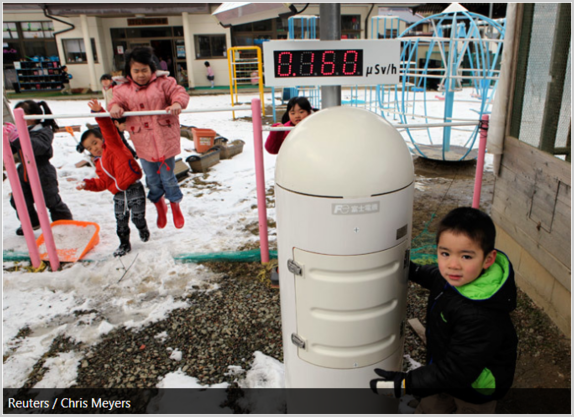
彼らは本当に彼らが何をしているのか理解していない。つまり、そのような間違いをし、間違ったポンプを使用する人々 、のようなものだ。
They don’t really understand what they’re doing. That’s the kind of people who use the wrong pump, who make mistakes like that.
「私は私の国のために本当に恥ずかしいんだけど、私は将来的にはきれいな地球を維持するために真実を話さなければならない。
“I’m really ashamed for my country, but I have to speak the truth for the sake of keeping our planet clean in the future.
第二次世界大戦の終わりに米国による広島と長崎の工業都市に原子爆弾の使用: Idogawaはその後、日本の歴史の中で最も悲劇的な出来事の一つといくつかの類似点を作った。
Idogawa then made some parallels with one of the most tragic events in the history of Japan: the use of atomic bombs on the industrial cities of Hiroshima and Nagasaki by the United States at the end of World War II.
「当局は(原爆投下の影響について)みんなに嘘をついた...彼らは真実を隠した。つまり、それはちょうど、福島ではありませんインチ我々は生きている状況です。日本はいくつかの暗い歴史を持っています。これは、過去に犠牲の一種である。 "
“The authorities lied to everyone (about the effects of the atomic bombings)...They hid the truth. That’s the situation we are living in. It’s not just Fukushima. Japan has some dark history. This is a sort of a sacrifice to the past.”
何の放射線に関連した死亡や労働者や一般の人々の間で観察急性疾患がなかったと言い、国連報告書の詳細に押されたとき、 Idogawaは高さに彼自身の経験の一部を提供する前に、「完全に偽」としてそれを閉じる危機の。
When pressed on the details of a United Nations report that says there have been no radiation-related deaths or acute diseases observed among the workers and general public, Idogawa dismisses it as “completely false,” before providing some of his own experiences at the height of the crisis.
私が市長だったとき」 、私は心臓発作で死亡した多くの人々を知っていたし、その後でも若者の間で、急死した福島の多くの人々があった。これは、国連から、当局は、全世界から真実を隠していることを本当に残念だ。私たちは、実際に多くの人が死んでいることを認めざるを必要があります。我々はそれを言うことはできませんが、東京電力の社員も死んでいる。しかし、彼らはそれについてMUM保管してください。 "
“When I was mayor, I knew many people who died from heart attacks, and then there were many people in Fukushima who died suddenly, even among young people. It’s a real shame that the authorities hide the truth from the whole world, from the UN. We need to admit that actually many people are dying. We are not allowed to say that but TEPCO employees also are dying. But they keep mum about it.”
このような状況下で死亡した人々の実際の数に立体図形を提供することを尋ねられたとき、 Idogawaはそれだけで1か2人ではない」と言って、控えて。我々は、この方法で死んだ十から二十人の話をしている。 "
When asked to provide solid figures on the actual number of people who died under such circumstances, Idogawa refrained, saying “it’s not just one or two people. We’re talking about ten to twenty people who died this way.”
日本が1.26億人々にエネルギー源を提供するために、彼は多くの川を持っているにもかかわらず、政府は水力エネルギーを促進するために無視していると回答している他のオプションについて質問した。
Asked about other options that Japan has for providing energy sources to its 126 million people, he responded that despite having many rivers, the government neglects to promote hydro energy.
なぜ?それは「大企業のための収益性の高い! "ではないので
Why? Because it’s not “profitable for big companies!”
Idogawaは驚くほど簡単に聞こえる日本のエネルギー需要を満たすための青写真を提供するために行く。
Idogawa goes on to provide a blueprint for fulfilling Japan’s energy needs that sounds surprisingly simple.
「私たちは、税別でも限られた投資で大人数での電気を供給することができます。ただ、重力を利用し、我々はもはや原子力発電所のための必要がないだろうほど多くのエネルギーを持っていることがあります。 」
“We can provide electricity for a large number of people even with limited investment, without taxes. Just use gravity, and we may have so much energy that there’ll be no need for nuclear plants anymore.”
災害の予感 / Premonitions of disaster
2011年3月11日に福島原子力発電所の大規模な障害が、一日東北日本の工場の6基の原子炉の3のメルトダウンを引き起こした地震津波に見舞われた前でさえも、 Idogawaは、施設は危険を知っていた。
Even before the massive failure at the Fukushima nuclear power plant on March 11, 2011, the day northeastern Japan was hit by an earthquake-triggered tsunami that caused the meltdown of three of the plant's six nuclear reactors, Idogawa knew the facility was dangerous.
「私はそれについて何も知らなかったふりをして、原子力発電所の事故の可能性についてのそれらを尋ねると、それは彼らが私の質問の多くに答えることができなかったが判明した"と彼は言った。それは最初に彼らの経営陣は、危機管理計画を持っていなかったことを私の心を交差させたときに、「率直に言って、それはです。それは私が施設が危険であることに気づいたことをしていた。 "
“I asked them about potential accidents at a nuclear power plant, pretending I didn’t know anything about it, and it turned out they were unable to answer many of my questions,” he said. “Frankly, that’s when it first crossed my mind that their management didn’t have a contingency plan. It was then that I realized the facility could be dangerous.”
津波が襲った日に近くの町にあることが起こった前市長は、地震のニュースをするとバック双葉への駆動振り返る。唯一の後、彼は彼が近づいて津波で命を失うことになったのか近くに発見しました。
The former mayor, who happened to be in a nearby town on the day the tsunami struck, recalled driving back to Futaba upon news of the earthquake. Only later did he discover how close he came to losing his life in the approaching tsunami.
「私は、大きな津波が来る前にそこに着くことができた。それは私が私が私が幸運...水を免れたことに気づいていることを後になった。私は道路から、山々まで運転した後に津波が来た。 "
“I managed to get there before the bigger tsunami came. It was only later that I realized that I escaped the water... I got lucky. The tsunami came after I drove off that road and up the mountains.”
防護服とマスクを着用し、メディアと東京電力( TEPCO )の従業員のメンバーは、福島県の津波不自由東京電力の福島第一原子力発電所2014年3月10日に第1原子炉建屋に向かって歩いてください。 (ロイター/徹花井)
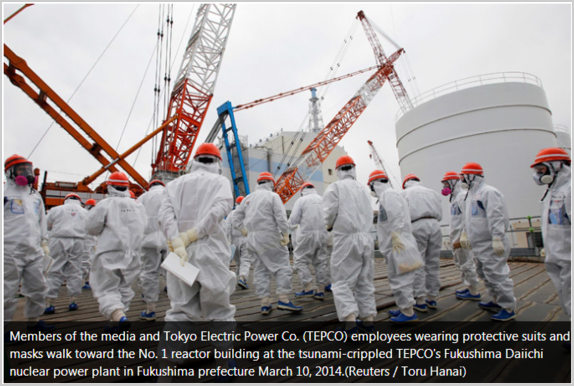
原子力発電所に関するご質問は、車で30分の自宅で彼の思考を支配した。 「私はちょうどそれが強い、何が発電所はどうなることだが ' 、考え続け?どのような原子炉が破損している場合は?どのような水漏れの場合?市は何をしますか?何が私が市長として行うのですか? ' "
Questions regarding the nuclear power plant dominated his thoughts on the 30-minute drive home. “I just kept thinking, ‘If it’s that strong, what will happen to the power plant? What if the reactor is damaged? What if the water leaks? What will the city do? What am I to do as mayor?’"
かつて彼のオフィスで、 Idogawa 井戸川克隆 は窓の外を見て、彼は説明したものによって直面した"恐ろしい光景。 "
「通常は、そこから海を見ることができなかったが、その時は私はちょうど300〜500メートル離れて、それを見ることができました"と彼は言った。
Once in his office, Idogawa looked out the window and was confronted by what he described as “a terrifying sight.”
“Usually you couldn’t see the sea from there, but that time I could see it just 300-500m away,” he said.
それは市長が、原子力発電所は、おそらく損傷のいくつかの並べ替えを受けていたことに気づいていることをその時点であった。テレビの報道を見て夜過ごした後も、携帯電話は動作しなかったため唯一の情報源は、 Idogawaは翌朝早く緊急避難したと発表しました。すべての住民のは、しかし、緊急放送を聞いた。
It was at that point that the mayor realized that the nuclear power plant had probably suffered some sort of damage. After spending the night watching news reports on television, the only source of information since even mobile phones were not working, Idogawa announced an emergency evacuation early the next morning. Not all of the residents, however, heard the emergency broadcast.
「その後、私は、すべての双葉の住民が私の発表を聞いたことを知った。私はそれについて罪悪感を感じる...私は福島県がタイムリーに私にすべての情報が与えられていなかったことが分かった。そして今、政府は、放射線から人々の安全を確保するためにあらゆる措置を講じておらず、避難手順の実施を監視していない。 "
“Later, I learned that not all Futaba residents heard my announcement. I feel guilty about that…I found out that the Fukushima prefecture hadn’t given me all the information in a timely fashion. And now the government isn’t taking any steps to ensure people’s safety from radiation, and isn’t monitoring the implementation of evacuation procedures.”
原子力エネルギーを超えてKatsutaka Idogawa 井戸川克隆 は、日本のエネルギー源のクリーン、安全な形への変換は、国の法律を変更する意思が必要となると考えています。
Beyond nuclear energy Katsutaka Idogawa believes a transformation to a cleaner, safer form of energy source for Japan would require a willingness to change the country’s laws.
「日本では多くの法律は、おそらくあまりにも多くあります。河川や彼らが慣れている方法についての法律があります。私たちは、農業用水の使用に関する法律を変更して電気を生産するため、川を使い始めることができます。一人でちょうどこの法律を変更すると、私たちは多くのエネルギーを生産することができます。 」
“There are many laws in Japan, perhaps too many. There are laws about rivers and the ways they’re used. We could change laws regarding agricultural water use and start using rivers to produce electricity. Changing just this law alone will allow us to produce a lot of energy.”
このすべてが「地球を汚染することなく。 」達成することができる
All of this could be accomplished “without contaminating our planet.”
あなたは大きな投資を必要としないので、このような大胆な提案は、「大企業にアピールしないと、大きな発電所を建設する必要はありません。それは資本家のために、投資家のためのその有益ではありません。 "
However, such bold proposals do not “appeal to big companies, because you don’t need big investments, you don’t need to build big power plants. It’s not that profitable for investors, for capitalists.」
しかし、核放射線によって失わ荒廃日本人町、市長のために、 Idogawaは世論に形成海の変化を感知。
But for the former mayor of a devastated Japanese town, lost to nuclear radiation, Idogawa senses a sea change forming in public opinion.
日本人は「我々は核の災害を回避する必要があることを認識し、その人口の60〜70 %が自然エネルギーを利用して支持している。 」し始めている
The Japanese people are beginning to “realize that we need to avert nuclear disasters, so 60-70 percent of the population is in favor of using natural energy.”
「それは私達に長い時間がかかりましたが、ある日、私たちは、ドイツ、ヨーロッパの例に従うだろう。 」
“It took us a long time, but one day we’ll follow the example of Europe, of Germany.”
http://rt.com/news/tokyo-radiation-fukushima-children-836/
http://rt.com/shows/sophieco/fukushima-disaster-radiation-children-740/
福島:従順で自分の意見がなく大勢に従う人々に、5分メモ:NWO手下を見よ - 140305
FUKUSHIMA: 5-min MEMO TO SHEEPLE: BEHOLD THE NWO MINIONS - 140305
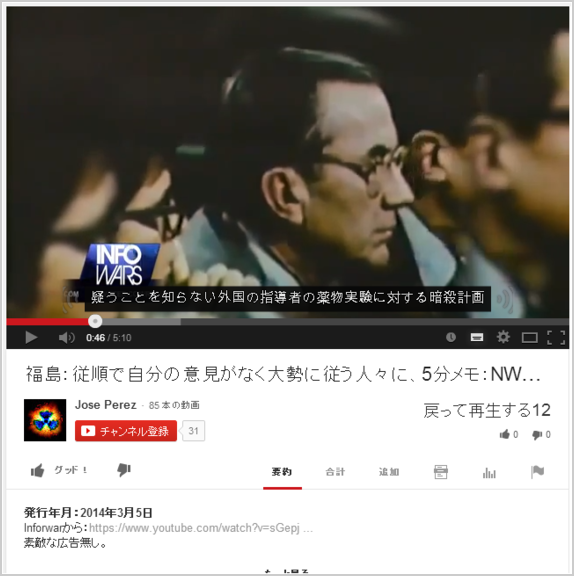
福島の余波を探る / Exploring the Aftermath of Fukushima
デヴィッド·ローゼンバーグによる / By David Rosenberg
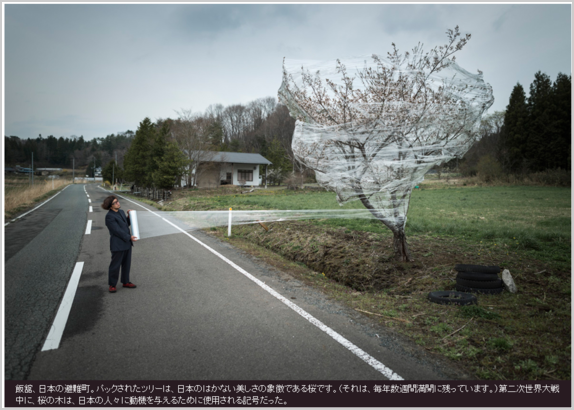
飯舘、日本の避難町。パックされたツリーは、日本のはかない美しさの象徴である桜です。(それは、毎年数週間満開に残っています。)第二次世界大戦中に、桜の木は、日本の人々に動機を与えるために使用される記号だった。
The evacuated town of Iitate, Japan.The packed tree is a cherry blossom, which is the symbol of ephemeral beauty in Japan.(It remains in bloom for a few weeks each year.) During World War II, the cherry-blossom tree was the symbol used to motivate the Japanese people.
ウィキペディアフリー百科事典から
From Wikipedia, the free encyclopedia
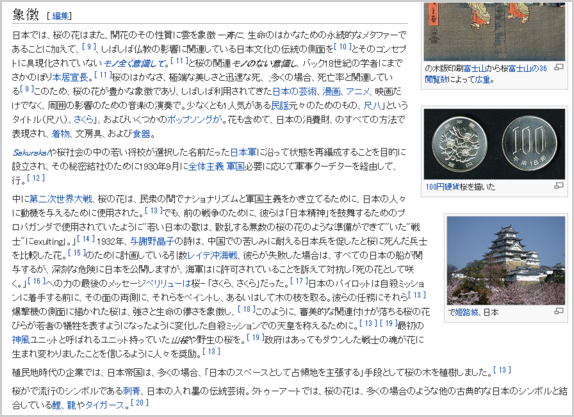
中に第二次世界大戦、桜の花は、民衆の間でナショナリズムと軍国主義をかき立てるために、日本の人々に動機を与えるために使用された。
During World War II, the cherry blossom was used to motivate the Japanese people, to stoke nationalism and militarism among the populace.
http://en.wikipedia.org/wiki/Cherry_blossom
米国の船員弁護士:福島は精神的、物理的に不自由若者の全体の世代を残しているし、遺伝的に - 核放射線は(オーディオ)を地球全体を脅かしている
US Sailors’ Attorney: Fukushima has left an entire generation of young people crippled physically, mentally, and genetically — Nuclear radiation is threatening entire planet (AUDIO)
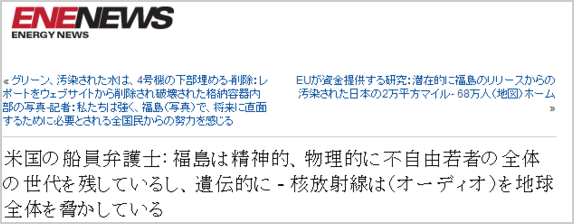
Operation Tomodachi / 友達作戦
http://enenews.com/us-sailors-attorney-fukushima-has-left-an-entire-generation-of-young-people-crippled-physically-mentally-and-genetically-crippled-nuclear-radiation-threatening-entire-planet-audio
震災の時にトモダチ作戦に参加したアメリカ の救援部隊が、東京電力に対し約1900億 ...
Relief troops of the United States who participated in Operation Tomodachi at the time of the earthquake, about 190 billion .... for TEPCO

http://lucifer.ldblog.jp/archives/24644949.html
マイルズ·オブライエンは、福島の放射線のために、PBS釣りを取り
Miles O’Brien Takes PBS Fishing for Radiation at Fukushima
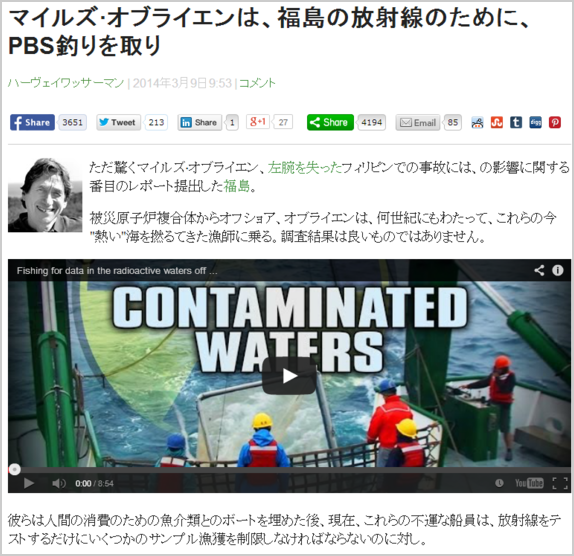
・・・福島吹き始めた非常にすぐ後に、実際には、オバマ大統領は、米国に来て、放射線が微小かつ無害であることを世界に約束した。
In fact, very soon after Fukushima began to blow, President Obama assured the world that radiation coming to the US would be minuscule and harmless.
彼は、これが本当である科学的証拠を持ちませんでした。
He had no scientific proof that this would be the case.
オブライエンの8分のピースがあまりにも明確に示していますように、「全く損害賠償を支払うこと、悪を見ない」の精神はここに働いている。
And as O'Brien's eight-minute piece shows all too clearly, the “see no evil, pay no damages” ethos is at work here.
政府は魚類の放射線レベルのない監視を行っておらず、海の汚染に関する情報は、ほとんど完全にBuesselerのような積立不足の研究者によって生成されます・・・
The government is doing no monitoring of radiation levels in fish, and information on contamination of the ocean is almost entirely generated by underfunded researchers like Buesseler...
http://ecowatch.com/2014/03/09/miles-obrien-pbs-fishing-radiation-fukushima/
FALSE / 虚偽
日本の原子力ウォッチは今、福島からの放射性の水の漏れ宣言した「非常事態」。
Japan's nuclear watchdog has now declared the leak of radioactive water from Fukushima a "state of emergency."
毎日、放射性の水を300トンが海に浸透しており、東京電力は計り知れない大きさの2年半の隠蔽工作に従事していることが明らかだ。
Each day, 300 tons of radioactive water seeps into the ocean, and it's now clear that TEPCO has engage in a two-and-a-half-year cover-up of immense magnitude.
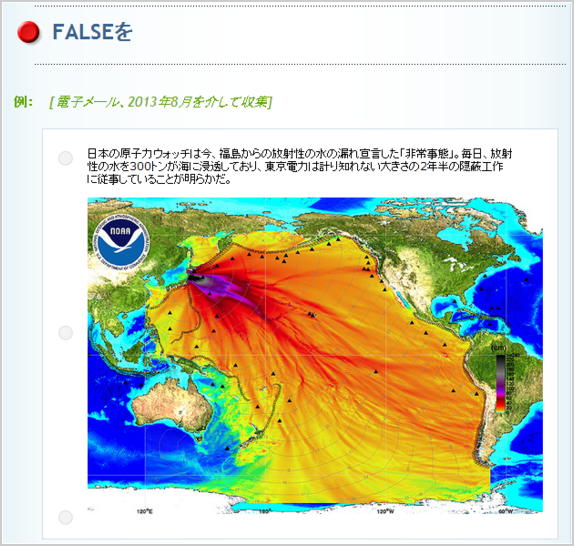
http://www.snopes.com/photos/technology/fukushima.asp#3RxTMukvvMKtTlXV.99
- グーグルで記事を読む